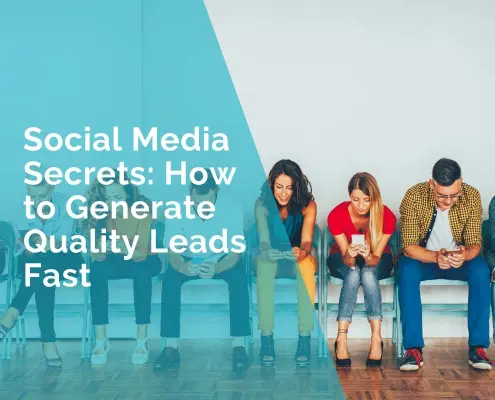Transform Your Website into a Lead Generation Powerhouse
Why Lead Generation Matters
Imagine having a steady stream of potential customers coming to your business every day. This is what lead generation can do for you. It’s about attracting people who are interested in what you offer and turning them into customers.
Common Problems with Lead Generation
Many small business owners struggle with getting enough leads. Their websites may not be attracting visitors, or those who do visit aren’t taking the next step. This can be frustrating and can slow down business growth.
Understanding Lead Generation
What is Lead Generation?
Lead generation is the process of attracting people who might be interested in your product or service. Think of it as a way to gather contact information from potential customers, like their name and email address. This helps you reach out to them later with offers, updates, or more information. Lead generation is important because it helps grow your business by turning visitors into customers.
Types of Leads
Leads can be divided into three main types:
- Cold Leads: These are people who don’t know much about your business. They might have just stumbled upon your website or seen an ad. For example, someone who sees a Facebook ad for a new bakery in town is a cold lead.
- Warm Leads: These people have shown some interest in what you offer. They might have visited your website a few times, signed up for your newsletter, or downloaded a free guide. For instance, if you run a fitness studio, a person who signs up for a free workout video is a warm lead.
- Hot Leads: These are people who are ready to make a purchase. They’ve done their research, compared options, and decided that your product or service is what they need. An example would be someone who adds a product to their cart on your e-commerce site and is about to check out.
The Lead Generation Funnel
The lead generation funnel is a way to visualize the journey of a lead from the first contact to becoming a customer. Here are the basic stages:
- Awareness: At this stage, people learn about your business. They might find you through search engines, social media, or word of mouth. For example, a person searching for “best local restaurants” finds your restaurant’s website.
- Interest: Now that they know about you, they start to show interest. They might read your blog, browse your products, or follow you on social media. A person visiting your blog post on “top home cleaning tips” is in the interest stage.
- Decision: Here, they are considering whether to buy from you. They might compare your product with others or read customer reviews. For instance, a person looking at reviews for your accounting software is in the decision stage.
- Action: Finally, they make a purchase or contact you for more information. A customer signing up for your online cooking class has reached the action stage.
Assessing Your Current Website
Audit Your Website
To improve lead generation, you first need to understand how your website is currently performing. Here’s how to do it:
- Check Your Traffic: Use tools like Google Analytics to see how many people visit your site. Look at where they are coming from (e.g., search engines, social media, direct visits).
- Analyze Conversion Rates: This is the percentage of visitors who take the desired action, like filling out a form or making a purchase. A low conversion rate might mean your site needs some changes.
- Look at Bounce Rates: This is the percentage of visitors who leave your site after viewing only one page. A high bounce rate can indicate that visitors aren’t finding what they’re looking for.
Key Metrics to Analyze
- Traffic: How many people visit your site.
- Conversion Rates: How many visitors turn into leads or customers.
- Bounce Rates: How many visitors leave after viewing one page.
- Average Session Duration: How long visitors stay on your site.
- Pages Per Session: How many pages visitors view during a single visit.
Identifying Weak Points
Common areas where websites fail in lead generation include:
- Poor Website Design: A cluttered or outdated website can turn visitors away. For example, a law firm’s website with too much text and no clear calls to action might lose potential clients.
- Slow Load Times: If your site takes too long to load, visitors may leave before they even see it. An online store with high-resolution images that aren’t optimized can suffer from this.
- Complicated Forms: If your contact forms are too long or ask for too much information, people might not fill them out. A local gym asking for detailed personal info just to download a free pass may discourage leads.
- Unclear Value Proposition: If visitors don’t quickly understand what you offer and why it’s valuable, they won’t stick around. A consulting firm that doesn’t clearly explain their services on the homepage might lose potential clients.
Enhancing Website Design and User Experience
Responsive Design
It’s crucial for your website to be mobile-friendly. More people are using their phones and tablets to browse the internet, and if your site doesn’t work well on these devices, you could lose potential customers. For example, imagine you run a local bakery. If someone searches for your bakery on their phone and your site is hard to navigate, they might give up and choose a different bakery. A mobile-friendly site adjusts to fit any screen size, making it easy for visitors to read and interact with your content.
Speed Optimization
A fast website is essential for keeping visitors. If your site takes too long to load, people are likely to leave before they even see your content. This is especially true for e-commerce sites. For example, if you sell handmade crafts online, a slow site can frustrate customers, causing them to leave and buy from a competitor. You can improve your site’s speed by compressing images, using faster web hosting, and minimizing the use of heavy scripts and plugins.
Navigation and Layout
Your website should be easy to use. Visitors should find what they’re looking for without any trouble. Clear menus, simple layout, and logical organization are key. For instance, if you own a hair salon, your site should have clear sections for services, prices, and booking appointments. Avoid clutter and keep it simple. Use large, readable fonts and make sure your contact information is easy to find.
Creating Compelling Content
High-Quality Content
Content is what keeps visitors on your site and turns them into leads. High-quality content provides value, answers questions, and solves problems. For example, if you run a gardening shop, you can write articles about plant care tips or create guides on how to start a vegetable garden. This type of content attracts visitors who are interested in your products and builds trust with your audience.
Blogging and Articles
Regularly updating your blog with new articles can help keep your site fresh and engaging. Consistent content updates show that your business is active and knowledgeable. For instance, a financial advisor could write weekly articles on budgeting tips or investment strategies. This not only attracts new visitors but also keeps existing visitors coming back for more information.
Video and Multimedia
Different people prefer different types of content. While some love reading articles, others might prefer watching videos. Including videos and other multimedia on your site can help engage a wider audience. For example, if you own a cooking school, you can create video tutorials for popular recipes. This can attract people who are interested in cooking and may want to sign up for your classes. Other multimedia like infographics and slideshows can also help explain complex information in a simple and engaging way.
“For small businesses, effective lead generation is not just a strategy—it’s the essential path to building relationships and expanding your reach.“
Ivana Katz
Effective Use of CTAs (Calls to Action)
Strategic Placement
Where you place your CTAs can make a big difference. CTAs are buttons or links that tell visitors what you want them to do next, like “Sign Up” or “Get a Quote.” They should be easy to find and placed where they make sense. For example, a CTA button at the end of a blog post asking readers to “Subscribe for More Tips” is well-placed. If you run an online clothing store, placing a “Shop Now” button next to product descriptions can encourage more sales.
Design and Copywriting
CTAs should stand out and be clear. Use bright colors that contrast with the rest of your website to draw attention. The text should be short and action-oriented. For instance, instead of a vague “Submit,” use specific actions like “Join Now” or “Download Free Guide.” If you run a fitness center, a CTA saying “Get Your Free Workout Plan” is more appealing than just “Submit.”
Investing in this aspect, whether by hiring a full-time collaborator or a freelance copywriting service, can simplify the work significantly and enhance results, as effective communication is crucial.
A/B Testing CTAs
Testing different versions of your CTAs can help you find what works best. A/B testing involves changing one element of your CTA at a time, such as the color or wording, and seeing which version gets more clicks. For example, you might test a red “Buy Now” button against a green one to see which gets more clicks in your online store. By continuously testing and tweaking, you can improve your CTAs over time.
Optimizing Landing Pages
Key Elements of High-Converting Landing Pages
A landing page is a dedicated page for a specific marketing campaign, like a special offer or sign-up form. To be effective, it should have a clear headline, a brief description of the offer, and a strong CTA. For example, a home cleaning service might create a landing page for a discount on first-time cleanings. The page should clearly state the discount, provide a few bullet points about the benefits, and include a “Get Your Discount” button.
Simplified Forms
Keep your forms short and only ask for essential information. Too many fields can discourage people from filling them out. For example, a webinar sign-up form might only need a name and email address. If you need more information, consider asking for it later in the process.
Clear Value Proposition
Your landing page should clearly explain what visitors will get and why it’s valuable. If you offer a free consultation for your marketing services, explain what they can expect from the consultation and how it will benefit their business. This helps visitors understand why they should take action.
Leveraging Lead Magnets
Types of Lead Magnets
Lead magnets are free offers designed to capture contact information. Common types include ebooks, webinars, free trials, checklists, and discount codes. For example, a real estate agent might offer a free ebook on “10 Tips to Sell Your Home Fast” to attract potential sellers.
Creating Valuable Offers
Your lead magnet should provide real value to your target audience. If you run a software company, offering a free trial of your software can show potential customers its benefits firsthand. Make sure your lead magnet solves a problem or provides useful information.
Promotion Strategies
Once you have a great lead magnet, you need to promote it. Use your website, social media, email newsletters, and even paid ads to spread the word. For example, a personal trainer might promote a free meal plan through Facebook ads and their Instagram page. The more places you promote your lead magnet, the more people you can attract.
By effectively using CTAs, optimizing landing pages, and leveraging lead magnets, you can significantly boost your website’s lead generation capabilities. These strategies help guide visitors toward taking action, making it easier for you to grow your business.
Incorporating Social Proof
Testimonials and Reviews
Showing customer feedback on your website is a great way to build trust. When visitors see positive reviews from real customers, they are more likely to believe in your product or service. For example, a local bakery can display quotes from happy customers who loved their cakes. If you run a plumbing service, posting reviews from satisfied clients can reassure potential customers that you’re reliable.
Case Studies and Success Stories
Sharing detailed examples of how your product or service has helped others can be very convincing. A case study tells a story about a customer’s problem, how you solved it, and the results they achieved. For instance, a marketing agency can write a case study about how they helped a small business increase their online sales by 50%. If you are a fitness trainer, you could share a success story of a client who lost weight and improved their health with your training program.
Social Media Proof
Engagement on social media can also act as social proof. When people see others liking, sharing, and commenting on your posts, it shows that your business is popular and trustworthy. For example, a restaurant might share photos of happy customers enjoying their meals, along with positive comments from social media. If you sell handmade crafts, showing the number of followers and positive interactions on your Instagram page can help build trust with potential buyers.
Marketing Automation and CRM Integration
Email Marketing Automation
Automating your email marketing can save you time and help nurture leads. Set up automated emails to send a welcome message when someone signs up, follow-up emails with useful information, and special offers to keep them engaged. For example, an online bookstore can send automated emails with recommendations based on previous purchases. If you run a gym, you can automate emails to remind members about upcoming classes or special events.
CRM Systems
A Customer Relationship Management (CRM) system helps you track and manage your leads. It keeps all your customer information in one place, making it easy to follow up and build relationships. For instance, a real estate agent can use a CRM to track potential buyers, schedule follow-up calls, and record their preferences. If you run a software company, a CRM can help you keep track of which clients need support and when to reach out for renewals.
Lead Scoring
Lead scoring helps you prioritize leads based on their likelihood to become customers. By assigning points to different actions (like visiting your pricing page or downloading a guide), you can focus on the most promising leads. For example, an online course provider might give higher scores to leads who watch a free webinar, showing they are more interested. If you sell business software, you might score leads higher if they request a demo.
You have the power to turn your website into a lead generation machine. By making these changes, you can attract more visitors, keep them engaged, and turn them into loyal customers. It may take some effort, but the results will be worth it.
To transform your website into a lead generation powerhouse, remember these main strategies:
- Enhance Website Design and User Experience: Make your site mobile-friendly, fast, and easy to use.
- Create Compelling Content: Offer valuable information through blogs, articles, and multimedia.
- Use Effective CTAs: Place clear, engaging calls to action where they’ll have the most impact.
- Optimize Landing Pages: Design landing pages that are clear, focused, and easy to use.
- Leverage Lead Magnets: Offer valuable freebies like ebooks or webinars to attract leads.
- Incorporate Social Proof: Use testimonials, case studies, and social media to build trust.
- Automate Marketing and Use CRM: Save time and manage leads effectively with automated emails and CRM systems.
Start today by assessing your website and making small improvements. As you see progress, keep refining your strategies. The more you put into it, the more you’ll get out of it. Good luck!
Additional Resources
Further Reading
- “Content Marketing for Small Businesses” by Joe Pulizzi
- “The Ultimate Guide to Email Marketing” by Mailchimp
- SEO for Beginners” by Moz
Tools and Software Recommendations
- Google Analytics: For tracking website traffic and performance
- Mailchimp: For email marketing automation
- HubSpot CRM: For managing customer relationships
- Canva: For creating engaging visuals and graphics
Frequently Asked Questions
What is lead generation and why is it important for my website?
Lead generation is the process of attracting and converting visitors into potential customers by capturing their interest and contact information. It’s important because it helps grow your business by building a list of people who are interested in your products or services, making it easier to market to them and convert them into paying customers.
How can I improve my website’s lead generation?
To improve lead generation, focus on enhancing your website’s design, making it mobile-friendly, speeding up load times, creating high-quality content, and using strong calls to action (CTAs). Additionally, optimize your landing pages, use lead magnets like free ebooks or webinars, and incorporate social proof such as testimonials and reviews.
What is a call to action (CTA) and where should I place it on my website?
A CTA is a prompt on your website that encourages visitors to take a specific action, like “Sign Up,” “Get a Quote,” or “Buy Now.” Place CTAs in visible and logical spots, such as at the end of blog posts, on product pages, in the header or footer, and in pop-up forms to maximize their impact.
How does website speed affect lead generation?
A fast website keeps visitors engaged and reduces the chances of them leaving due to slow load times. Faster websites improve user experience, which can lead to higher conversion rates. Optimize images, use efficient hosting, and minimize heavy scripts to improve your site’s speed.
What are landing pages and how do they help with lead generation?
Landing pages are standalone web pages created for a specific marketing campaign, designed to capture leads by providing information and a strong CTA. Effective landing pages are clear, focused, and offer something valuable, like a free trial or discount, to encourage visitors to take action.
What types of content should I create to attract leads?
Create valuable content that addresses your audience’s needs and interests. This can include blog posts, articles, videos, infographics, and podcasts. For example, a fitness trainer could offer workout tips, while a real estate agent might provide home-buying guides.
What are lead magnets and how can they help my business?
Lead magnets are free offers designed to capture contact information from potential customers. Examples include ebooks, webinars, checklists, and discount codes. They provide value to your audience and encourage them to share their contact details, helping you build a list of leads to nurture.
How can I use social proof to boost lead generation?
Social proof includes testimonials, reviews, case studies, and social media engagement. Displaying positive feedback from happy customers builds trust and credibility, making new visitors more likely to become leads. For example, a software company might share user reviews and case studies showing how their product has helped businesses succeed.
 Ivana Katz from Websites 4 Small Business is an award winning web designer who builds websites that build your business. She provides unbeatable web design services to fit your budget.
Ivana Katz from Websites 4 Small Business is an award winning web designer who builds websites that build your business. She provides unbeatable web design services to fit your budget.
The end result? Professional, custom-made sites that give your business the extra oomph it needs to stand out from the competition and make an impact.
Whether you’re a brand-new business or an established one ready to improve your digital presence, Ivana makes it easy to get your business online very quickly. Her websites are professional, tailored to fit your budget, and give your business a serious boost.
Download your FREE copy of “Ultimate Website Design Secrets Blackbook – 10 Bulletproof Strategies for Designing an Outrageously Successful Website”












